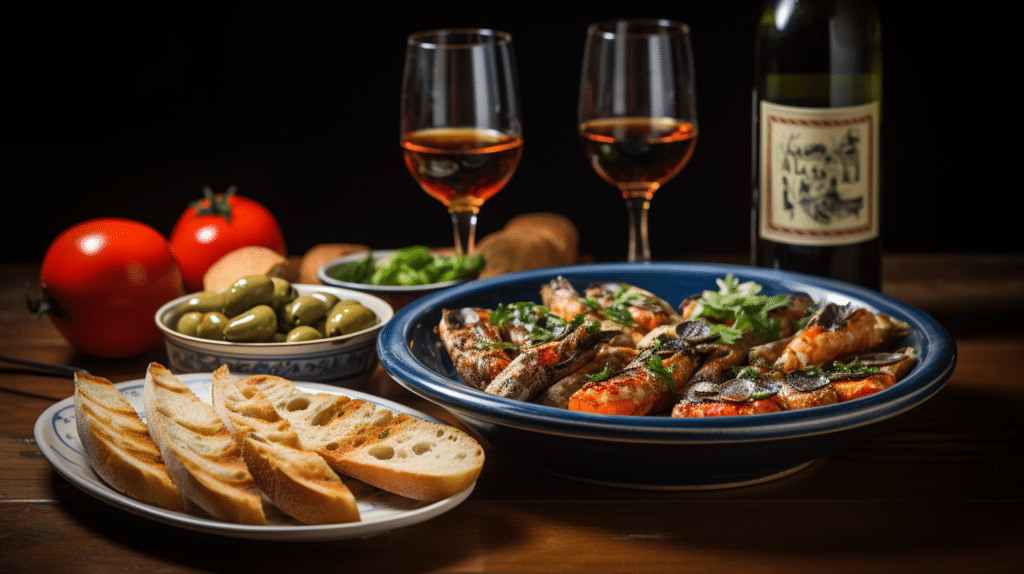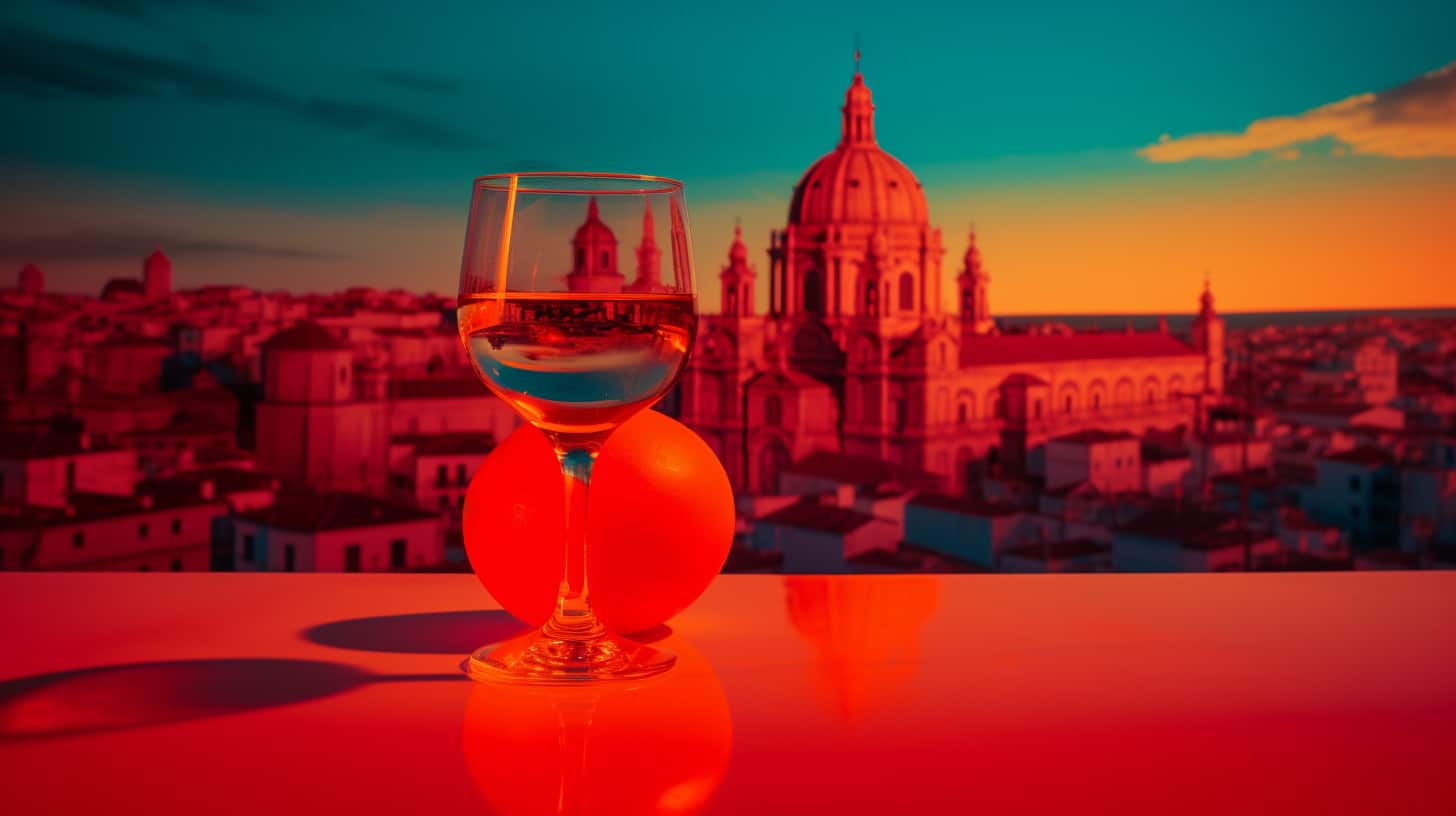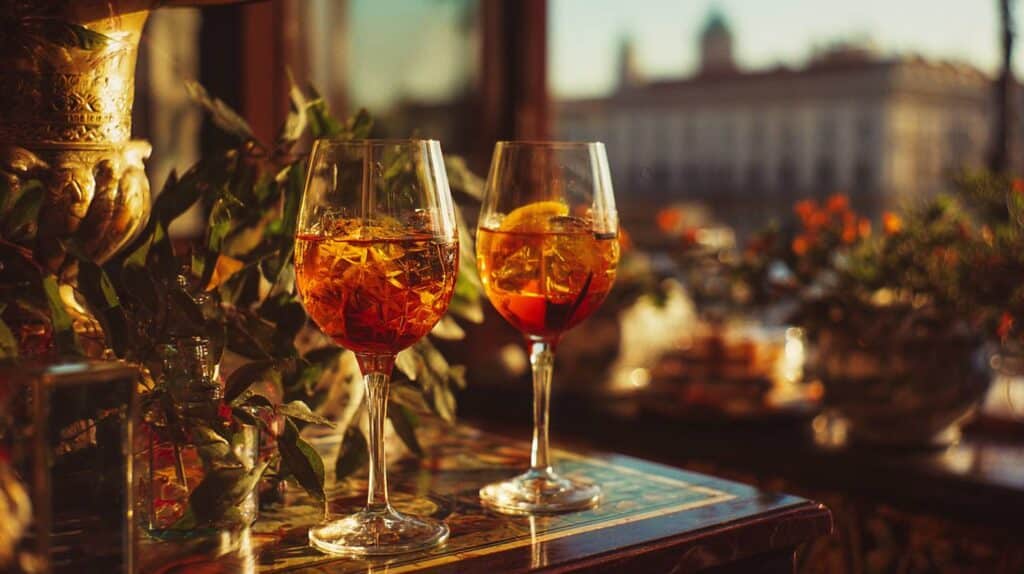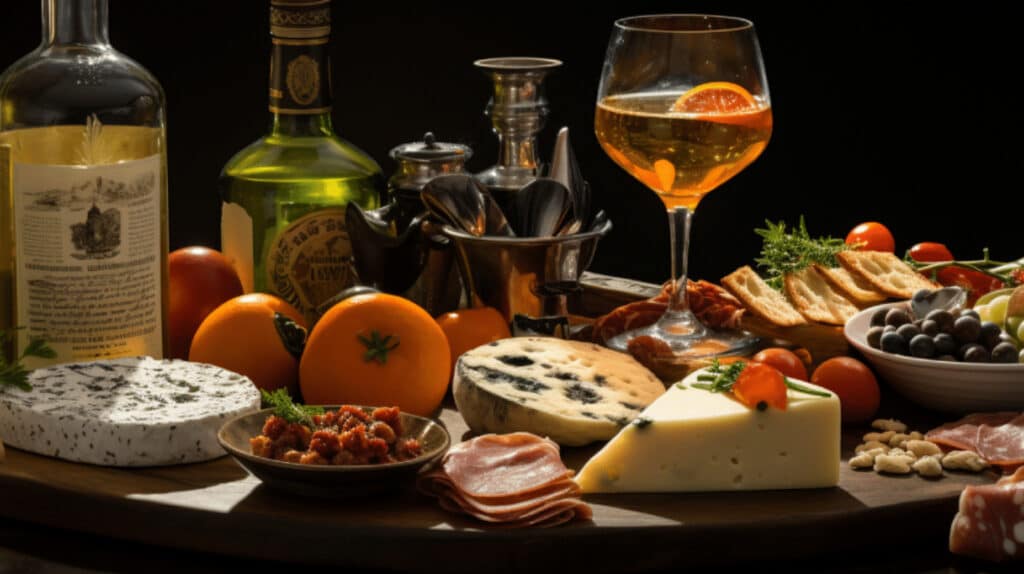The one about vermouth wine in Spain is a captivating tale that transcends mere culinary preference, weaving itself into the very fabric of the nation’s culture. While vermouth may have Italian origins, it has found a fervent following in Spain, where it has been wholeheartedly embraced, adapted, and celebrated. This fortified wine has not only become a staple in Spanish households but has also evolved into a cultural phenomenon, complete with its own dedicated time slot in the Spanish day, known as “la hora del vermut”.
This article aims to delve deep into Spain’s relationship with vermouth, exploring its historical journey, unique flavour profiles, and its indelible impact on Spanish culture and lifestyle. Whether you’re an aficionado of this complex beverage or a curious explorer, prepare to embark on a fascinating journey that uncovers why vermouth has become an integral part of Spain’s culinary and cultural landscape.
The Historical Journey of Vermouth in Spain
The story of vermouth in Spain is a fascinating narrative that begins in the late 19th century, when this fortified wine made its way from Italy to Spanish shores. Initially considered an exotic import, vermouth soon found a receptive audience among the Spanish populace, who were already well-acquainted with wine culture. The drink quickly gained prominence, and by the early 20th century, it had become a staple in Spanish households and taverns alike.
Spanish entrepreneurs and winemakers seized the opportunity to create their own versions of vermouth, using local white wines as the base. Regions like Reus in Catalonia and Chinchón near Madrid became renowned for their distinctive vermouths, each with its unique blend of botanicals and spices. Over time, vermouth wine in Spain developed its own identity, distinct from its Italian and French counterparts, characterized by a sweeter, more fruit-forward profile.
The drink’s popularity led to the establishment of “la hora del vermut”, a dedicated time usually before lunch when Spaniards would gather to enjoy a glass of vermouth, often accompanied by tapas. This ritual became so ingrained in Spanish culture that it has its own designated slot in the Spanish meal schedule, usually extending the prologue to the traditional Sunday lunch.

In recent years, Spanish vermouth has experienced a remarkable resurgence. A new generation of winemakers and mixologists has embraced this age-old beverage, experimenting with new flavours, techniques, and even single-varietal grapes. This revival has not only elevated the status of Spanish vermouth but has also led to its international recognition, with exports rising steadily.
Today, vermouth wine in Spain is more than just a drink; it’s a cultural icon that encapsulates the nation’s rich history, culinary diversity, and social rituals. Whether enjoyed in a bustling Madrid tavern or a quiet Catalonian café, each sip is a nod to a tradition that has stood the test of time.
The Unique Flavours Vormouth Wine in Spain Vermouth
When it comes to flavour profiles, Spanish vermouth offers a kaleidoscope of tastes that set it apart from its Italian and French cousins. One of the defining characteristics of Spanish vermouth is its sweeter, more fruit-forward nature, often achieved through the use of local white wines as the base. This sweetness is then beautifully balanced by a complex blend of botanicals, spices, and herbs, creating a harmonious symphony of flavours that dance on the palate.

Brands like Lustau, Martínez Lacuesta, and Casa Mariol are at the forefront of innovation in the Spanish vermouth scene. Lustau, for instance, offers a range of vermouths that showcase the unique characteristics of sherry wines, adding an extra layer of complexity. Martínez Lacuesta takes a more traditional approach, using time-honoured recipes but experimenting with different types of oak barrels for ageing, which imparts additional nuances to the flavour. Casa Mariol, on the other hand, has ventured into the realm of single-grape vermouths, using local varietals to create a product that is both unique and deeply rooted in Spanish terroir.
The botanicals used in vermouth wine in Spain also contribute to its distinct flavour profile. While artemisia and wormwood are common ingredients, Spanish brands often incorporate local herbs like rosemary, thyme, and even saffron, adding a touch of the Mediterranean to each sip. The result is a vermouth that can range from herbaceous and earthy to citrusy and floral, offering a wide array of options for both drinking and mixing.
In recent years, rosé vermouth has also made its appearance in Spain, adding yet another dimension to this already diverse category. Made from rosé wines, these vermouths offer a lighter, more refreshing alternative, perfect for summer sipping.
Whether you prefer your vermouth neat, on the rocks, or as a key component in a cocktail, the unique flavours of Spanish vermouth provide a versatile and exciting experience, inviting you to explore a world of taste that is as diverse as it is delightful.
La Hora del Vermut: A Cultural Phenomenon
In Spain, the act of enjoying vermouth transcends the mere consumption of a beverage; it’s a cultural institution known as “la hora del vermut” or “the vermouth hour”. This ritual is not just a prelude to a meal but a social event in its own right, a time to gather with friends and family to engage in lively conversation while savouring a glass of this fortified wine.
The concept of “la hora del vermut” is deeply rooted in Spanish tradition and has been passed down through generations. It typically occurs late in the morning, extending into the early afternoon, often serving as the prologue to the traditional Spanish Sunday lunch. During this time, bars and cafés are abuzz with activity, as patrons enjoy their vermouth often accompanied by small plates of tapas like olives, anchovies, or potato chips.

This cultural phenomenon is not limited to any specific region but is embraced across the country, from the bustling streets of Madrid to the serene coastal towns of Andalusia. Each locale adds its unique flair to the ritual, whether it’s the choice of tapas, the style of vermouth, or even the accompanying music.The significance of “la hora del vermut” extends beyond the drink itself. It encapsulates the Spanish ethos of enjoying life’s simple pleasures, of taking time to relax and connect with loved ones. In a fast-paced world, this ritual serves as a reminder of the importance of slowing down, of savouring the moment, and of celebrating community.
What Types of Tapas Are Commonly Enjoyed During “La Hora del Vermut,” and How Do They Complement the Drink?
The ritual of “la hora del vermut” is as much about the food as it is about the drink. Tapas, those small but flavourful Spanish dishes, play a crucial role in this cultural phenomenon, serving as the perfect accompaniment to a glass of vermouth. The choice of tapas can vary depending on the region, personal preference, and even the specific type of vermouth being served, but there are some staples that are commonly enjoyed across Spain.
Olives are perhaps the most quintessential tapa for vermouth. Their briny, salty flavour contrasts beautifully with the sweet, herbaceous notes of the vermouth, creating a balanced taste experience. Varieties like Manzanilla or Gordal olives are particularly popular.
Anchovies are another favourite, offering a burst of umami that complements the complex flavours of the vermouth. Whether they are served in oil, vinegar, or even in a tomato-based sauce, anchovies add a depth of flavour that elevates the drinking experience.
Potato chips, often homemade and seasoned with a touch of sea salt, provide a crunchy contrast to the smooth, velvety texture of the vermouth. Their simplicity allows the intricate flavours of the vermouth to shine, making them an ideal pairing.
In some regions, more elaborate tapas like “boquerones en vinagre” (white anchovies in vinegar) or “patatas bravas” (spicy potatoes) make an appearance, adding a touch of culinary flair to the occasion.
The beauty of tapas during “la hora del vermut” lies in their ability to enhance the vermouth without overshadowing it. Each tapa is thoughtfully chosen to create a harmonious interplay of flavours and textures, turning the act of drinking vermouth into a multi-sensory experience that engages the palate, the nose, and even the eyes.
How Do Different Regions in Spain Add Their Unique Touch to the Ritual of “La Hora del Vermut?”
The ritual of “la hora del vermut” is a nationwide vermouth wine phenomenon in Spain, but its expression varies from region to region, each adding its unique touch to this cherished tradition. The local variations are influenced by factors such as regional cuisine, climate, and even historical influences, making “la hora del vermut” a diverse and multifaceted experience.
In Catalonia, for instance, vermouth is often enjoyed with a side of “escabeche,” a dish of fish or meat marinated in vinegar and spices. The tangy, complex flavours of escabeche pair excellently with the sweet and herbal notes of Catalan vermouths.
In Madrid, it’s common to see “bocadillos de calamares” (squid sandwiches) accompanying a glass of vermouth. The crispy, fried squid offers a delightful textural contrast to the smooth vermouth, and the combination is a local favourite.
In Andalusia, the hot climate lends itself to lighter, more refreshing tapas. Here, you might find “gazpacho” or “salmorejo,” cold tomato-based soups, served alongside your vermouth. The refreshing nature of these dishes complements the fortified wine, making for a balanced and enjoyable experience.
In the Basque Country, “pintxos,” small bites often served on a skewer, are the tapas of choice. These can range from seafood to cured meats, and they offer a wide array of flavours to complement the local vermouth.
Even the choice of vermouth can be regional. In Valencia, for example, it’s not uncommon to find vermouth made from the local Moscatel grape, adding a unique, floral note to the drink.
These regional variations enrich the ritual of “la hora del vermut,” making it a truly Spanish experience that reflects the diversity and richness of the country’s culinary and cultural landscape.
How Do the Flavours of Different Tapas Interact with the Various Types Vermouth Wine in Spain?
The interplay between tapas and Spanish vermouth is a culinary ballet, where each element enhances and complements the other. The variety of Spanish vermouths, each with its unique blend of botanicals, spices, and base wines, offers a wide spectrum of flavours that can be expertly paired with different types of tapas.
For instance, a vermouth with a strong herbal profile, featuring notes of rosemary and thyme, pairs wonderfully with olives stuffed with anchovies or piquillo peppers. The saltiness of the anchovies and the mild heat of the peppers balance the herbal notes, creating a harmonious flavour experience.

A fruit-forward vermouth, often featuring citrus and berry notes, goes exceptionally well with seafood tapas like “boquerones en vinagre” (white anchovies in vinegar) or “gambas al ajillo” (garlic prawns). The acidity and umami from the seafood tapas accentuate the fruity characteristics of the vermouth.
For vermouths with a more bitter or spiced profile, tapas like “patatas bravas” (spicy potatoes) or “chorizo al vino” (chorizo cooked in wine) can be an excellent choice. The spiciness of these dishes adds complexity to the vermouth, making each sip a new discovery.
In the case of rosé vermouths, which are lighter and often more floral, tapas like “ensaladilla rusa” (Russian salad) or “tortilla española” (Spanish omelette) offer a mild, creamy counterpoint that allows the delicate flavours of the vermouth to shine.
The key to successful pairing lies in understanding the flavour profile of the vermouth and selecting tapas that either contrast or complement those flavours. Whether you’re enjoying a traditional “la hora del vermut” or experimenting at home, the possibilities for delightful pairings are endless.
Modern Takes and Innovations
The world of Spanish vermouth is not one that rests on its laurels; it is continuously evolving, driven by a new generation of winemakers, mixologists, and enthusiasts who are pushing the boundaries of what this fortified wine can be. This spirit of innovation has led to a plethora of modern takes that are redefining the Spanish vermouth landscape.
One of the most exciting trends is the rise of craft vermouths. Small-batch producers are experimenting with single-varietal grapes, unique botanical blends, and even barrel-aging techniques to create vermouths that are as complex as they are unique. Brands like Vermut Mercadal and El Bandarra are leading the way, offering artisanal vermouths that challenge traditional norms.
Another innovation is the concept of “vermouth on tap”, a trend that has taken off in urban bars and trendy establishments. This not only ensures the freshest pour but also allows for a rotating selection of vermouths, giving patrons the opportunity to explore different styles and flavours.
Seasonal vermouths are also making an appearance, crafted to highlight the flavours of specific times of the year. Think spiced vermouths with notes of cinnamon and clove for the winter, or floral, citrusy vermouths that are perfect for summer sipping.
Even the ritual of “la hora del vermut” is getting a modern makeover, with some bars offering vermouth-based cocktails that go beyond the classic “vermut con sifón” (vermouth with soda water). From vermouth Negronis to vermouth spritzers, the options are expanding, offering a contemporary twist to a time-honoured tradition.
These modern takes and innovations are not just a testament to the versatility of vermouth wine in Spain; they are a celebration of its enduring appeal and its ability to adapt and thrive in a changing world.
Conclusion
The Spanish love affair with vermouth is a multifaceted narrative that encapsulates history, culture, and a relentless pursuit of culinary excellence. From its historical journey and integration into Spanish society to the rich tapestry of flavours it offers, Spanish vermouth is more than just a drink; it’s a cultural institution. The ritual of “la hora del vermut” exemplifies this, turning an ordinary moment into a celebration of life’s simple pleasures.
The modern takes and innovations in the world of Spanish vermouth are a testament to its enduring appeal and its ability to adapt to contemporary tastes. Whether it’s the rise of craft vermouths, the trend of vermouth on tap, or the introduction of seasonal varieties, Spanish vermouth continues to evolve while staying true to its roots.
As we’ve explored the unique flavours, the pairing with tapas, and the regional variations, it’s clear that Spanish vermouth offers a rich and diverse experience that invites exploration. Whether you’re a seasoned aficionado or a curious newcomer, the world of Spanish vermouth is an exciting landscape that promises a journey of discovery with every sip.







